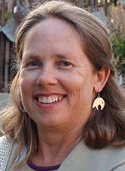The “ewww” factor notwithstanding, it is one of Earth’s ecological treasures that’s worth cherishing.
By Karen Telleen-Lawton, Noozhawk Columnist
If you grew up near beaches and brothers, you may not have good associations with seaweed. My memory could be faulty, but it seems like my brother would wait until I was resting my bikini-clad body on a towel in the sand when he’d heave a great mound of the sandy slime on my back. It was giant kelp, an ecosystem with crawly bugs and oozing tubers. So how can I now write lovingly of my brother and kelp?

My brother has fallen back into favor because I miss him. Seaweed I now appreciate because, the “ewww” factor notwithstanding, it is one of the hidden treasures of the Earth: the giant redwood of the sea forest. The kelp beds that line our coast from Santa Cruz to southern Baja provide fish nurseries and rich nutrients for otters and a multitude of invertebrates. Santa Barbara is the center of a wealth of research into kelp systems.
Since 2000, UCSB has housed the 24th site in the Long Term Ecological Research program established by the National Science Foundation in 1980. The Santa Barbara LTER’s primary research objective is “to investigate the relative importance of land and ocean processes in structuring giant kelp forest ecosystems.”
Why focus on kelp? In taking an Earth-wide view of ecosystem health, researchers saw a gap in understanding between coastal watersheds and near-shore marine environments. They determined that studying kelp systems could help bridge this gap.
More than a dozen LTER studies are in progress; other spinoffs involve commercial and nonprofit organizations. To cite one, you may have noticed that we no longer clear the beaches of kelp. Sanitized beaches may look pretty, but now we know that they are as healthy as a digestive tract stripped of healthy microbes and enzymes.
More than 70 percent of Southern California’s mainland shore is made of sandy beaches, and their health depends mostly on “external sources” of organic matter. Kelp washing up onshore sustains more than 800 species of organisms, from birds and sandcrabs to insects such as beachhoppers who live or feed in this zone. It turns out we’re not the only beach consumers!
Short-term studies already have shown positive results, including some in the area of social-ecological interactions. For instance, how can we continue economically and socially important activities such as fishing and kelp harvesting without negatively affecting the sustainability of giant kelp forests?
To answer this question, the Nature Conservancy teamed with UC Santa Cruz to lease 1,700 acres of kelp forest. The third partner was The Abalone Farm Inc., one node in the history of aquaculture farmers who have harvested kelp since the 1930s. Kelp provides algin, a thickening agent used in foods and cosmetics. Now, aquaculture farmers harvest 20 tons of kelp every other day to feed mollusks such as abalone.
After three years of experimentation, researchers showed that relatively minor changes could make a big difference. Harvesting half the amount of kelp from twice as many areas of forests allowed displaced species to relocate, preserving the health of the whole ecosystem.
If we can manage to keep the ocean healthy and harvest sustainably, there may be enough seaweed-wrapped sushi for everyone and their brother.
— Karen Telleen-Lawton serves seniors and pre-seniors as the principal of Decisive Path Fee-Only Financial Advisory in Santa Barbara. You can reach her with your financial planning questions at ktl@decisivepath.com.

